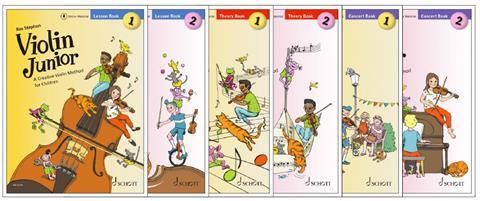Celia Cobb reviews Ros Stephen’s latest collection of method books aimed at younger players

Violin Junior
Ros Stephen
Lesson Book 1: 76PP
ISBN 9783795714925 €15
Concert Book 1: 36PP
ISBN 9783795715229 €15
Theory Book 1: 60PP
ISBN 9783795715250 €14
Theory Book 2: 60PP
ISBN 9783795715267 €14
Lesson Book 2: 84PP
ISBN 9783795715243 €15
Concert Book 2: 92PP
ISBN 9783795715236 €15
SCHOTT MUSIC
Violin Junior is a new set of method books by Ros Stephen, author of the popular Globetrotters series. Aimed at the younger learner, the books offer a thorough introduction to violin playing which is both child-friendly and also meticulously rigorous. Two levels of the series are currently available, taking the student from complete beginner through all the keys and techniques normally expected by around Grade 2; a further three levels are promised. As one would expect from a 21st-century series, a wealth of supplementary online material is offered, including demo and play-along audio tracks, along with a comprehensive series of mini-tutorial-style videos that highlight and explain the main teaching points of each section. As well as a ‘lesson book’ (for which piano and violin accompaniment books are available separately), each level has separate theory and concert books.
The volumes themselves are very well produced. The staves are large and easy to read, and the pages are full of tasteful colour drawings, which illustrate techniques and complement the written tips through the use of imagery, as well as adding a sprinkle of fun. And much as I’m not normally a big fan of cartoon characters, I must admit to having developed rather a weakness for Fiocco the Frog, with his garish pink jacket, endearing facial expressions and main character vibes, not to mention his pals, who include Marvin the Mouse (don’t squash him!) and some great dragons and other assorted creatures.
Read: Playing with a relaxed fourth finger by violinist Ros Stephen
Read: Adult string students bring unique challenges which can be very rewarding
The lesson books are carefully structured – every piece has an obvious main teaching purpose and builds on previously covered techniques. Book 1 follows the usual model of introducing fingered notes one at a time, which may not suit all teachers but is nevertheless consistent with the general principle of introducing only one new technique at a time. The musical language used is reasonably varied, though the majority of tunes lean towards a calm and pleasant style rather than anything more upbeat. Many of the tunes are presented as songs with words, which occasionally makes the pages feel a little busy. Throughout the books, as well as learning short accompanied pieces, the students are offered a variety of engaging activities, such as improvisation, transposition and composition exercises, as well as a smattering of micro studies focusing on specific techniques. The overall result is a very well-balanced mixture of serious technique and fun creativity.
The majority of the pieces in the lesson books are beautifully short, with the concert book offering longer pieces to provide extension and consolidation material as well as performance possibilities. The piano accompaniments are very accessible, if not terribly harmonically adventurous, and violin accompaniments are also included. While there are not many of what my students would call ‘bangers’, some of the author’s original compositions come close, especially my personal favourites Bus Stop Jig and Disco Beats.
The theory books for each level are full of violin-centric interactive exercises and games, and although there are clear links with the material covered in the lesson books, they can be worked through at the child’s own pace rather than in strict synchronisation with the lesson books. Audio content is included, as are downloadable solutions to some of the tasks, and even a selection of manuscript paper in different font sizes.
This well-thought-out, holistic series is precisely what self-described ‘non-musical’ parents have been demanding for years. The books are systematic and full of comprehensible and relevant information, and the online videos provide clear, calm instructions that will empower non-string-playing parents to help their young players at home. I imagine that it will become a favourite resource for many teachers and parents in the years to come, and I look forward to seeing the rest of the series as it becomes available.
CELIA COBB



































No comments yet